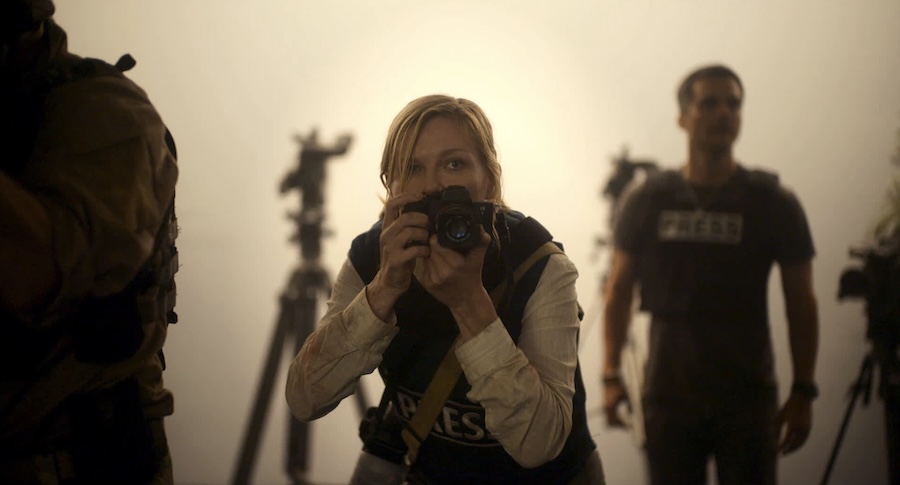
WELCOME TO THE FRONTLINE.

As former president Donald Trump tries to mount a comeback for the 2024 elections, America seems almost as divided as in 1861, at the start of the civil war. On one side we have red-state voters seduced by Trump’s lies and in denial over what happened when he tried to remain in power after losing the 2020 election. On the other side we have blue-state voters who barely recognize the other half as human beings anymore. How can a nation like that begin to heal?
Texas and California in an alliance
After the rise of a politician (Nick Offerman) who became president and started turning the nation into an autocracy, the United States fell apart. Texas and California formed a military alliance called the Western Forces and a war broke out between them and the U.S. military, led by the President, now in his third term. When this film begins, the war is not going well for the loyalist states and the Western Forces are drawing nearer to Washington, D.C., aiming to end the President’s unconstitutional rule.
We meet two war correspondents, Lee Smith (Kirsten Dunst) who’s a renowned photographer, and Joel (Wagner Moura), a reporter who works for Reuters. As they decide to drive to Washington, they’re joined by Sammy (Stephen McKinley Henderson), a veteran New York Times reporter, and Jessie Cullen (Cailee Spaeny), a young aspiring photographer who idolizes Lee.
In the middle of a battle
The journey through a very dangerous landscape becomes an ordeal for all of them, and a chance for Jessie to learn the profession, if she survives and develops the ability to pick up a camera instead of simply reacting to a crisis emotionally. Much of the film is a depiction of how war correspondents handle challenges; the filmmakers bring the realities of Ukraine, Gaza and other war-torn places to the American heartland. This isn’t a documentary that tears our hearts out the way real wars do, but there’s an ambition to show what it’s like to be there in the middle of a battle, to feel fear, despair, anger – as well as the adrenaline rush. We in the audience also experience all that, and we grow close to the men and women in the white car headed for D.C., especially Dunst as the jaded photographer who hates the idea of having young Jessie trail along, thinking that it’ll only end in her death.
This is where the film reaches its climax, dragging us along for the bloodthirsty chase after the man who started it all
Director Alex Garland, who’s made visually compelling films throughout his career, continues in the same vein here. Together with his filmmaking team, he stages the final battle with ferocious intensity, leading up to an attack on the White House, now part of a walled compound. This is where the film reaches its climax, dragging us along for the bloodthirsty chase after the man who started it all, our correspondents documenting the destruction of the city and war crimes as they happen. One thing is for sure, there are no winners or heroes here.
We don’t really know the political agendas of either side; by lumping Texas and California together, two states that differ a lot politically, the director wants us to forget about Republicans and Democrats, and Trump even. This movie isn’t about the current conflicts, but what might happen if we’re not careful. Might seem like a cowardly approach, and that’s what some critics were thinking, but if Garland had made Civil War about the here and now he wouldn’t have had a chance to reach both sides, and the film trembles with the urgency to do so.
When Garland, who’s British, wrote the script for this film, he intended it as a warning to the United States. It’s a horrifyingly effective one.
Civil War 2024-U.S.-U.K. 109 min. Color. Written and directed by Alex Garland. Cinematography: Rob Hardy. Cast: Kirsten Dunst (Lee Smith), Wagner Moura (Joel), Cailee Spaeny (Jessie Cullen), Stephen McKinley Henderson, Nick Offerman, Sonoya Mizuno. Cameo: Jesse Plemons.
Last word: “Overall I’d say this film is about checks and balances: polarization, division, the way populist politics leads toward extremism, where extremism itself will end up and where the press is in all of that. One of the things that really preoccupied me four years ago was it was perfectly obvious there were really good journalists doing good work. But the thing that interested me, and this has been happening for a while, is how little traction they had. If it’s a film about checks and balances, one of the biggest checks and balances you have on government is the press. But the press needs to be trusted for that to work. They’ve been undermined and demonized partly by external forces and internal forces.” (Garland, The New York Times)
